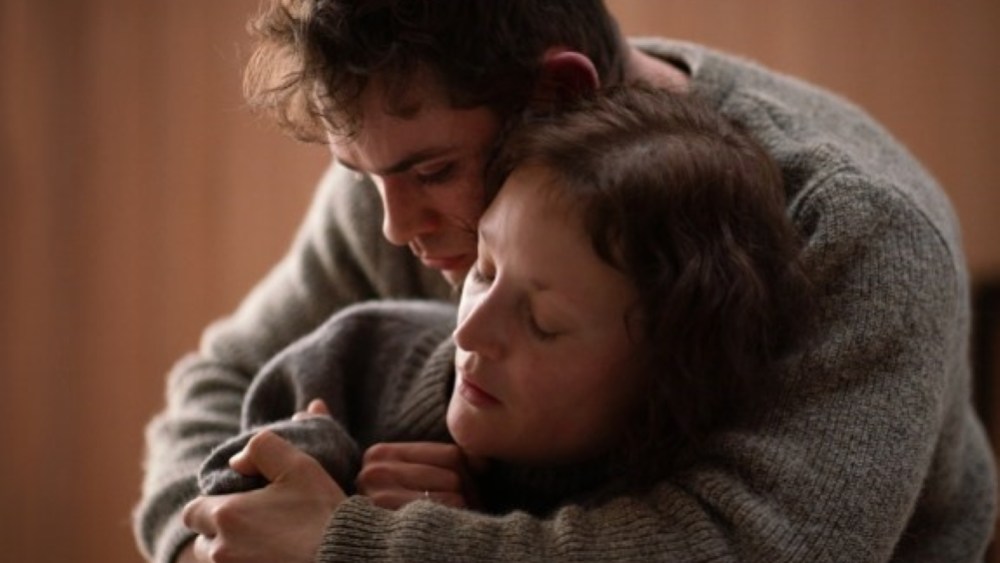Maybe because so many of them were cautionary tales, but traditional nursery rhymes can be unnerving as hell when you unpack the meaning beneath the cheery tune. Among the strangest of them all (perhaps ranking right below the deadly-plague-related “Ring around the Rosie”) is “Jack and Jill.” You know, the pair who went up the hill to fetch a pail of water: The first falls down, and the second comes tumbling after.
That familiar nursery rhyme loosely sits at the center of writer-director Samuel Van Grinsven’s austere ghost story, “Went Up the Hill,” a somber and serious meditation on love, grief and unfinished business centered on a couple named Jack and Jill, played by Dacre Montgomery and Vicky Krieps. The pair give exacting performances laced with blink-and-you’ll-miss-it details around shifts in facial expressions, body language and even speech intonation. That’s because both Jack and Jill are haunted by the dead — and not just metaphorically, but also physically — and their behavior tends to vary slightly when the ghost takes over their forms.
They are each haunted by the very same ghost: a brilliant artist named Elizabeth, who is Jill’s dearly departed wife, and Jack’s estranged mother. That detail makes their performances even more impressive, as Krieps and Montgomery are tasked with playing not only their respective characters, but also an echo of Elizabeth, and even of each other, jointly harmonizing their performances to ensure that they render Elizabeth on similar terms. For audiences, the process of detecting their subtle performative shifts is worth the price of admission alone.
Elizabeth never enters the movie in any corporeal way, but the presence of her spirit looms large over the entire gloomy tale, co-written by Jory Anast. Words like “ghost,” “spirit” and “haunted” might give the wrong idea. Tonally, this beautifully photographed, enigmatic little genre exercise is less in the vein of supernatural horror (even though it offers some understated chills along the way) and more in the vicinity of Joanna Hogg’s “The Eternal Daughter” or the Rudyard Kipling story “They,” heartbreaking tales about the afterlife where a sense of remorseful sadness, and not jump-scares, is at the forefront.
Admittedly, Grinsven’s film falls short of the expressive depth of these examples on the whole, leaving a lot to be desired when it comes to the emotional devastation such stories may offer. But the film’s wild, icy and rural visuals, captured grandly by cinematographer Tyson Perkins, are astonishingly gorgeous to meditate in. And the nuances in the lead actors’ performances manage to expand on the intrigue and limited plot of the story, elevating a film that sometimes feels like it could have just as easily been a short.
The film starts in earnest with Elizabeth’s funeral in a minimalist, remote, high-end New Zealand house, surrounded by breathtaking, monochrome vistas: hills, valleys, frozen bodies of water, set against a vast horizon and enveloped by blue-green shades of gray. The choice of location feels at once inevitable and enormously consequential for the film, doing its own narrative heavy-lifting in suggesting an atmospheric severity and sense of loneliness (echoed by the eerie sound design) when Jack arrives at the funeral unannounced, insisting that it was Jill who invited him.
Not only does Jill have no idea who Jack is or who might have invited him, no one in Jill’s company feels particularly pleased to see Jack. The dismissive hostility becomes clearer when Elizabeth’s stern sister Helen (a scene-stealing Sarah Peirse, with a growing significance in the tale) suggests that her sibling had two loves only: her home and Jill.
Since “Went Up the Hill” is billed as a ghost story, we’re way ahead of all the characters in answering, “Who invited Jack to the funeral?” But thankfully, we’re still treated to some surprises along the way, including how Jack and Jill would come to learn about one another through Elizabeth, inside the walls of Jill’s minimally decorated and furnished home that looks (quite intentionally) more like a Scandinavian design showroom than a real, lived-in home. For instance, Jill’s bedroom consists of just a simple mattress placed directly on the floor, next to Elizabeth’s coffin.
Thanks to this sparseness, there is an intimate, stageplay quality to Grinsven’s interiors, an elegant bareness that allows us to focus on the performances. The haunting starts soon after Jack’s arrival, as the backstory of the characters emerge in small, fragmented drips. There is a troubling suggestion of abuse, implying that Jack might have been ill-treated by his mom (and saved by Helen), rather than heartlessly abandoned. As Jack and Jill allow Elizabeth to take over night after night, their closeness gradually grows, too, to the point where the two have sex through moves that feel mechanically orchestrated. The suggestion here is that Elizabeth possesses Jack during it — maybe she does, maybe she doesn’t.
Since “Went Up the Hill” is ultimately about the ways in which humans mourn loss, what feels real to Jack and Jill is more important than knowing if there is really a ghost that unites them. In that, both Krieps and Montgomery remain deeply committed to their characters, making sure that we meet them where they are mentally and psychologically. Maybe “Went Up the Hill” could afford to rattle us a bit more emotionally, but it still leaves behind a graceful inquiry into grief.

